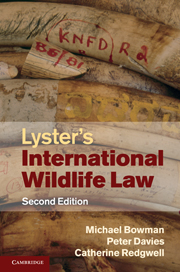Book contents
- Frontmatter
- Contents
- Foreword
- Preface
- List of abbreviations
- PART I Foundations of international wildlife law
- PART II Species regulation
- PART III Regional wildlife regulation
- PART IV Global wildlife regulation
- PART V Biological diversity: a new perspective on wildlife regulation
- 17 The Biodiversity Convention and Biosafety Protocol
- 18 Deserts, forests and mountains
- PART VI Cross-sectoral issues in wildlife regulation
- PART VII Conclusion
- Index
- References
17 - The Biodiversity Convention and Biosafety Protocol
Published online by Cambridge University Press: 05 July 2011
- Frontmatter
- Contents
- Foreword
- Preface
- List of abbreviations
- PART I Foundations of international wildlife law
- PART II Species regulation
- PART III Regional wildlife regulation
- PART IV Global wildlife regulation
- PART V Biological diversity: a new perspective on wildlife regulation
- 17 The Biodiversity Convention and Biosafety Protocol
- 18 Deserts, forests and mountains
- PART VI Cross-sectoral issues in wildlife regulation
- PART VII Conclusion
- Index
- References
Summary
Background
Biological diversity is an umbrella term referring to the degree of nature's variety. The concept is often used loosely to indicate the total number of species in a given area, or even to highlight particular endangered species such as the African rhinoceros, the blue whale, or the spotted owl. More specifically, it is understood to refer to the existence of diversity or variety at various key levels of biological organisation. Scientists tend to differ as to the number of levels they choose to identify for the purpose, though a minimum of three are commonly specified, namely (a) diversity of ecosystems (or habitat diversity), (b) diversity of species and (c) genetic diversity (within species). This threefold classification is the one adopted in the 1992 Biodiversity Convention, which defines ‘biological diversity’ as ‘the variability among living organisms from all sources including, inter alia, terrestrial, marine and other aquatic ecosystems and the ecological complexes of which they are a part: this includes diversity within species, between species, and of ecosystems’ (Article 2).
It is not possible precisely to determine the total number of species on Earth, because new species are being discovered all the time – about 1.7 million have been identified and named, including not only animals and plants but also life forms which are sometimes overlooked in the ‘biodiversity count’, such as micro-organisms. The total is estimated at anywhere from 5 million to 100 million.
- Type
- Chapter
- Information
- Lyster's International Wildlife Law , pp. 587 - 629Publisher: Cambridge University PressPrint publication year: 2010



